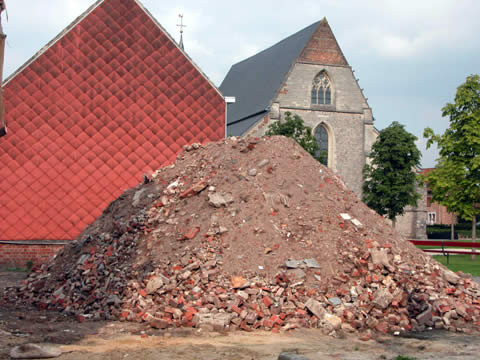Lara Almarcegui
10 Sep - 07 Nov 2010
LARA ALMARCEGUI
September 10 – November 7, 2010
Lara Almarcegui, 2010
Lara Almarcegui’s projects examine processes of urban transformation driven by political, social, and economic changes.
In the Guides she has produced in several cities since 1999, she explores the past and future of certain areas, documenting the complex narratives inscribed upon them in photographs, site plans, analyses of the existing state of affairs, and field reports. Her research concentrates on places and situations that have either been neglected by urban and land-use planners, architects, and developers due to a one-sided focus on surface design and profits, or their structural and commercial development is immediately imminent: abandoned lots, contemporary ruins, or brownfields.
Lara Almarcegui, The Rubble Mountain, Sint-Truiden 2005
Many other works by the artist similarly reflect the idea of the city as a complex structure shaped by ongoing demolition and (re)construction: Almarcegui renovated a market hall in San Sebastián (1995) even though its demolition was scheduled; refurbished a dilapidated garden shed (Phalsbourg, 2000); and replaced a section of intact asphalt pavement in Amsterdam’s fairground (2004). On a number of occasions, Almarcegui undertook a quantitative analysis of edifices: in Construction Materials São Paulo City (2006), for instance, she calculated the amounts of construction materials used for all sorts of buildings, shacks, and roads as well as the city’s subway network, listing her findings in a wall text. For The Rubble Mountain (Sint-Truiden, 2005), Almarcegui chose a lot where a house had stood and had the corresponding mass of construction materials heaped up on it.
For the Secession, Lara Almarcegui is conceiving three new works. Two will analyze the specific architectonic structure of the Secession’s building, while the third project will engage the urban development area of Vienna’s Nordbahnhof railway station.
Lara Almarcegui (*1972 in Zaragoza) lives and works in Rotterdam.
September 10 – November 7, 2010
Lara Almarcegui, 2010
Lara Almarcegui’s projects examine processes of urban transformation driven by political, social, and economic changes.
In the Guides she has produced in several cities since 1999, she explores the past and future of certain areas, documenting the complex narratives inscribed upon them in photographs, site plans, analyses of the existing state of affairs, and field reports. Her research concentrates on places and situations that have either been neglected by urban and land-use planners, architects, and developers due to a one-sided focus on surface design and profits, or their structural and commercial development is immediately imminent: abandoned lots, contemporary ruins, or brownfields.
Lara Almarcegui, The Rubble Mountain, Sint-Truiden 2005
Many other works by the artist similarly reflect the idea of the city as a complex structure shaped by ongoing demolition and (re)construction: Almarcegui renovated a market hall in San Sebastián (1995) even though its demolition was scheduled; refurbished a dilapidated garden shed (Phalsbourg, 2000); and replaced a section of intact asphalt pavement in Amsterdam’s fairground (2004). On a number of occasions, Almarcegui undertook a quantitative analysis of edifices: in Construction Materials São Paulo City (2006), for instance, she calculated the amounts of construction materials used for all sorts of buildings, shacks, and roads as well as the city’s subway network, listing her findings in a wall text. For The Rubble Mountain (Sint-Truiden, 2005), Almarcegui chose a lot where a house had stood and had the corresponding mass of construction materials heaped up on it.
For the Secession, Lara Almarcegui is conceiving three new works. Two will analyze the specific architectonic structure of the Secession’s building, while the third project will engage the urban development area of Vienna’s Nordbahnhof railway station.
Lara Almarcegui (*1972 in Zaragoza) lives and works in Rotterdam.


